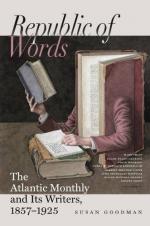This comes only from the Nimbus, which is quite unlike the others. It puts on a dark gray color, has irregular transparent edges, and increases rapidly so as to obscure the sky. It appears to absorb the other clouds, to be a union of their differently electrified particles, which are attracted to each other, form drops of water, and descend as rain.
Of the first three forms we have three modifications or varieties. The Cirro-Cumulus is a congeries of roundish little clouds in close horizontal position, varying in size and roundness, and often, to use the words of the poet Bloomfield, appearing as “The beauteous semblance of a flock at rest.”
The Cirro-Stratus is more compact than the Cirrus,—the strata being inclined or horizontal. It is sometimes seen cutting the moon’s disc with a sharp line. The Cumulo-Stratus, or Twain Cloud, is denser than the Cumulus, and more ragged in its outlines. It overhangs its base in folds, and often bears perched on its summit some other form of cloud, which inosculates itself with it. Sometimes a Cirro-Stratus cloud comes along and fastens itself to it parasitically. It is one of our most picturesque forms of clouds.
Within the last two years we have twice observed in the city of New York, during the summer afternoons, large masses of clouds coming over from the southwest, and hanging rather low, which could not be well placed in any of the classes already described, or recognized as such by meteorologists. They consisted of a great number of hemispherical forms of large diameter, hanging vertically from a Stratus cloud or plane above them, and to which they appeared attached. They were regular in shape, and very distinct; they barely touched each other, and were of a gray color. They might be compared to a hay-field turned upside down, with innumerable hay-cocks hanging below it. Unfortunately, the circumstances under which the spectacle was observed did not; admit of any resort to the barometer, thermometer, or anemometer. Should further observations verify these remarks, it might perhaps be proper to style this variety the Hemispherical.
* * * * *
Dew is another atmospheric product. It is the condensation of the warmer vapor of the atmosphere, in calm and serene nights, and in the absence of clouds, by the cold surface of bodies on which it rests. In some countries it is copious enough to supply the want of rain. The earth radiates its own acquired heat, grows colder than the atmosphere, and so condenses it.
What is thermometrically called the dew-point is that degree at which the moisture present in the atmosphere, on being subjected to a decrease of temperature, begins to be precipitated or condensed. It is the same as the point of saturation. Daniell calls it “the constituent temperature of atmospheric vapor.” It is our criterion for ascertaining how much moisture there is in the air, and at what degree of heat or cold it would be precipitated. When the air is saturated, a dry bulb and a wet bulb will read alike.




